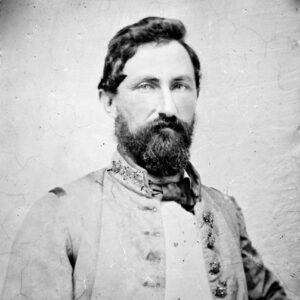calsfoundation@cals.org
William Lewis Cabell (1827–1911)
A talented and respected Confederate brigadier general, William Lewis Cabell performed most of his Civil War service in the Trans-Mississippi Department in Arkansas. He served several terms as mayor of Dallas, Texas, between the mid-1870s and mid-1880s. The exact meaning of his nickname “Old Tige” is not clear, but it may refer to his tenacity and stern discipline.
William Lewis Cabell was born in Danville, Virginia, on January 1, 1827, to Sallie Doswell Cabell and lawyer and military officer Benjamin Cabell. He graduated from the United States Military Academy at West Point in 1850 and served initially as a second lieutenant in the Seventh U.S. Infantry. Following his promotion to first lieutenant in June 1855, Cabell served as regimental quartermaster on the staff of General Persifor Frazer Smith (as well as Smith’s successor, Brigadier General William S. Harney), during the Utah Expedition of 1857–1858. Promoted to captain in March 1858, Cabell served on the frontier at Fort Arbuckle and Fort Cobb in Indian Territory.
Cabell married Harriet Amanda Rector in Fort Smith (Sebastian County) on July 22, 1856, and they had seven children.
Cabell resigned from the U.S. Army in March 1861 and accepted a Confederate commission as major in charge of the commissary, quartermaster, and ordnance departments in Richmond, Virginia. He then served as chief quartermaster on the staffs of generals P. G. T. Beauregard and Joseph E. Johnston, and he helped design the Confederate battle flag. In January 1862, Cabell joined the staff of Major General Earl Van Dorn in the Trans-Mississippi Department, where he rendered important service during the Confederate retreat after the Battle of Pea Ridge in March. Cabell withdrew across the Mississippi River with much of the Confederate army and commanded a brigade of Arkansas troops at the battles of Iuka and Corinth in Mississippi. Cabell sustained wounds at Corinth and Hatchie’s Bridge.
Following his recovery and promotion to brigadier general, Cabell assumed command of Confederate troops on the White River, with headquarters at Jacksonport (Jackson County) in February 1863. In the spring of 1863, Cabell attempted to regain control of northwestern Arkansas. On April 18, 1863, he attacked Colonel Marcus LaRue Harrison in Fayetteville (Washington County). After an intense and prolonged engagement, Cabell withdrew his force into the Boston Mountains, leaving Harrison’s Union forces in control of northwestern Arkansas. In April 1864, during the Camden Expedition, Cabell led a brigade of Arkansas cavalry in the division of Major General James Fleming Fagan at the Engagement at Poison Spring and the Action at Marks’ Mills. Captured on October 25, 1864, at the Battle of Mine Creek in Kansas during Major General Sterling Price’s Missouri Raid, Cabell spent the rest of the war as a prisoner at Johnson’s Island in Ohio and Fort Warren in Massachusetts.
Released on July 24, 1865, Cabell initially settled in Fort Smith and worked as a civil engineer and attorney. In 1872, Cabell moved to Dallas and won election as mayor in three non-consecutive terms in 1874, 1877, and 1883, during which time he championed several modern improvements in services and utilities that helped facilitate the city’s growth and prosperity after Reconstruction. Cabell also served as vice president of the Texas Trunk Railroad Company until his 1885 appointment as U.S. marshal for the Northern District of Texas. He held this post until 1889. Like many former Confederate officers, the seventy-one-year-old Cabell offered to serve in the U.S. Army during the Spanish-American War; the War Department declined.
Cabell remained active in Confederate veterans’ affairs and philanthropic organizations, serving as commander of the Trans-Mississippi Department of the United Confederate Veterans (UCV) from 1890 until shortly before his death, and as a member of the Dallas lodge of the Benevolent and Protective Order of the Elks. Cabell converted to Catholicism late in life.
His wife died in Fort Smith in 1887 at the age of forty-nine. William Lewis Cabell died in Dallas on February 22, 1911, and is buried at Greenwood Cemetery.
For additional information:
Dallas Morning News, February 23, 1911.
Harper, Cecil, Jr. “William Lewis Cabell.” Handbook of Texas Online. https://tshaonline.org/handbook/online/articles/fca02 (accessed July 19, 2018).
Harvey, Paul, Jr. Old Tige: General William L. Cabell, CSA. Hillsboro, TX: Hill Junior College, 1970.
Warner, Ezra J. Generals in Gray. Baton Rouge: Louisiana State University Press, 1959.
William L. Cabell Civil War Letter (MSS.11.17). Butler Center for Arkansas Studies. Central Arkansas Library System, Little Rock, Arkansas. Finding aid online at http://cdm15728.contentdm.oclc.org/cdm/ref/collection/findingaids/id/3466 (accessed July 19, 2018).
Robert Patrick Bender
Eastern New Mexico University–Roswell
 Civil War through Reconstruction, 1861 through 1874
Civil War through Reconstruction, 1861 through 1874 Military
Military William Cabell
William Cabell  William Cabell
William Cabell 




Comments
No comments on this entry yet.